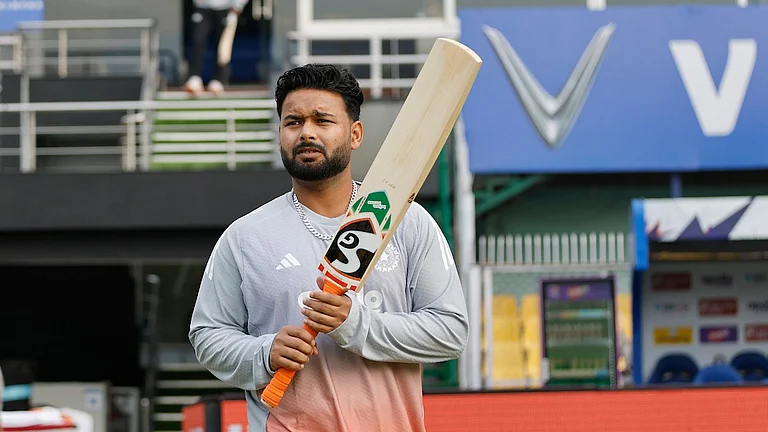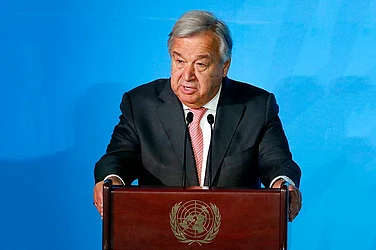Prime Minister Benjamin Netanyahu on Saturday announced that the Israel-Hamas War has entered the second stage.
The Israeli military has been operating on the ground in the Gaza Strip against Hamas and allied groups since Friday. After conducting nightly raids for days, the forces have been operating continuously in the region amid ramped-up aerial and artillery bombardment.
The Israeli government has not yet termed the ongoing operations inside as an 'invasion' and observers have said that Israel is conducting narrower, focused operations in Hamas-controlled Gaza in place of a full-fledged wider ground invasion that had been anticipated for weeks.
Israel launched 'Operation Sword of Iron' after Hamas and allied Palestinian groups launched an all-out offensive on Israel on October 7, dubbed the 'Operation Al Aqsa Storm'. At least 1,400 were killed, around 5,300 were injured, and at least 230 were abducted and taken to Gaza as hostages in the attack. Israel has conducted airstrikes since then to take down Hamas leaders and facilities, which have also caused widespread Palestinian casualties, with Gazan authorities saying at least 8,000 have been killed, including at least 3,000 children.
Even as Israel conducts hundreds of airstrikes daily as infantry and armour operate on the ground, Gaza-based Hamas and Lebanon-based Hezbollah, both supported by Israel's arch-rival Iran, have shown no signs of ending their rocket attacks on Israel. On the 23rd day of the war, the two groups continued to launch rockets into Israel on Sunday, which continued to attract retaliatory Israeli strikes.
Here we explain what's Israel's plan for war in Gaza and what challenges it faces.
Understanding Israel's 3-stage plan for Hamas War
Israeli Prime Minister Benjamin Netanyahu on Saturday announced that the military has launched the second stage of the Israel-Hamas War after the decision was approved unanimously by the unity government's War Cabinet and the Security Cabinet.
Netanyahu has said the ongoing war is a decisive offensive against Hamas that's intended to eradicate it for once and all. He termed the current time as a do-or-die moment for the Jewish state.
"This is the second stage of the war, the goals of which are clear: Destroying Hamas's military and governing capabilities, and bringing the captives back home...There are moments in which a nation faces two possibilities: To do or die. We now face that test and I have no doubt how it will end: We will be the victors. We will do and we will be the victors," said Netanyahu at a press conference alongside fellow War Cabinet ministers Yoav Gallant and Benny Gantz.
While details about the ongoing ground offensive of Israel are scarce and there is a lack of clarity about Israel's endgame in the Gaza Strip except for the rhetoric around defeating Hamas, Gallant has said the war is going to be conducted in three stages and there is no intention to occupy Gaza after the war.
Earlier, Gallant told a parliamentary committee that the three stages would be like this:
Stage 1: The Israeli military would destroy Hamas's infrastructure.
Stage 2: The Israeli military would launch operations at lower intensity to eliminate pockets of resistance.
Stage 3: In the concluding phase, once the Israeli forces have removed Hamas, Gallant said Israel would remove itself from the "responsibility for life in the Gaza Strip, and the establishment of a new security reality for the citizens of Israel".
Hamas is a designated terrorist organisation and has controlled Gaza since 2007 when it drove out another Palestinian faction Fatah. Gaza is one of the two parts of the envisioned State of Palestine, with the other being West Bank. While Hamas has run Gaza since 2007, Fatah runs the internationally-recognised Palestinian National Authority (PNA) that runs the West Bank. Israel vacated Gaza after decades of occupation in 2005.
What do we know of Israeli ground operations in Gaza?
While a full-fledged ground invasion of Gaza had been anticipated since the beginning of the war on October 7, the evidence so far suggests that Israel is launching focused strikes supported by aerial and artillery bombardment in North Gaza.
The Israeli military on Saturday night said that it's conducting coordinated operations in Gaza. It said that it identified Hamas cells attempting to launch anti-tank missiles and mortar shells and struck them and identified and destroyed traps.
On Sunday, the Israeli military said its aircraft guided ground troops and struck Hamas structures, such as anti-tank missile launch targets.
There are reports that the Israeli military has clashed with Hamas personnel hiding in tunnels in the northern region. The Army Radio reported that a number of attackers came out of a tunnel in Gaza several hundred meters inside the territory and clashed with Israeli troops. The report said "a number" of them were killed.
Even as Hamas personnel clash with Israel amid expanded operations, rocket attacks continue unabated into Israel from Hamas in Gaza and Hezbollah in Lebanon. ToI reported that alerts were sounded all along southern Israel along the Gaza border and in the central Israeli towns of Tel Aviv, Herzliya, and Ra’anana. Channel 12 reported that a total of 1.5-2 million people were sent to shelters from the attacks.
In all, around 120,000 have been displaced internally in Israel in addition to hundreds of thousands of Palestinians being displaced in Gaza and several thousands in Lebanon from the ongoing exchange of fire between Israel, Gaza-based Hamas, and Lebanon-based Hezbollah.
The New York Times reported that visuals released by the Israeli military indicated it had entered Gaza at a minimum of three places.
The NYT further reported that the Israeli ground operations in Gaza appear to be in line with US advice that suggested to give up the wider invasion in favour of a more focused operation in northern Gaza.
"The Israelis improved and refined their plan after a concerted effort by [US Secretary of Defense] Mr. Austin and other officials, a U.S. official said on Saturday, speaking on condition of anonymity to describe war planning between allies...But the raids so far into Gaza by Israeli ground forces appear to be smaller and more narrowly focused than what had been described, suggesting that Israel had taken the Americans’ advice to heart, at least for now, American officials said on Saturday," reported NYT.
Challenges in Gaza ground operation
The presence of hostages and the presence of tunnels, some as deep as 130 feet below Earth, where Hamas stores weapons and fuel, complicate the Israeli war efforts. The Western nations have also pressed Israel to delay or tone down any plans of an invasion so that talks for the release of hostages could continue.
"A possible complicating factor for a full-scale invasion are the subterranean pathways and chambers controlled by Hamas, some as deep as 130 feet below ground and packed with weapons and ammunition. That is where the militant group is holding more than 200 hostages, Israel says," reported NYT.
Earlier, Outlook reported, "Besides hostages, there are also issues of an entrenched adversary in Gaza with months of planning and a real possibility of a multi-front war as Iran-backed groups in the region such as Hezbollah have already started clashing with Israel. The Israeli military is deployed along both the Gaza and Lebanon borders and a full-fledged multi-front war is the last thing it would want."
Israeli Prime Minister Benjamin Netanyahu has said that an "all for all" deal is under discussion, which means the release of all hostages in lieu of all Palestinian prisoners in Israeli jails. The Biden administration and Qatar are also part of the negotiations.
The humanitarian situation of Gaza is also a concern as a worsening situation would hamper international support to Israel. Hundreds of thousands of Palestinian civilians have been displaced in Gaza and several thousands of houses and dozens of schools and medical facilities have been damaged. As the Israel-Gaza border has been sealed and only humanitarian supplies are entering through the Rafah crossing at the Egypt-Gaza border, there is also a grave shortage of food, fuel, and medical supplies.
This may be among the reasons why a full-fledged operation has been ditched, as of now, in favour of a more focused operation. The Times of Israel has reported that Israel has restored two of the three water pipelines to Gaza and is set to enable much more aid in the coming days so that more people can move away from the battlefield in the country's north towards southern regions.
"In the coming week we were planning to increase dramatically the amount of assistance" headed for Gaza from Egypt, said Colonel Elad Goren of the Israeli military agency that coordinates with the Palestinians, as per Reuters. "We have marked a humanitarian zone in the southern Gaza Strip in the Khan Younis area ... we still recommend that the civilian population that evacuated will go to this zone."


























